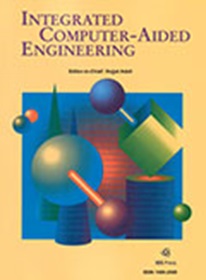A convolution-based distance measure for fuzzy singletons and its application in a pattern recognition problem
IF 5.3
2区 计算机科学
Q1 COMPUTER SCIENCE, ARTIFICIAL INTELLIGENCE
引用次数: 12
Abstract
A new method to measure the distance between fuzzy singletons (FSNs) is presented. It first fuzzifies a crisp number to a generalized trapezoidal fuzzy number (GTFN) using the Mamdani fuzzification method. It then treats an FSN as an impulse signal and transforms the FSN into a new GTFN by convoluting it with the original GTFN. In so doing, an existing distance measure for GTFNs can be used to measure distance between FSNs. It is shown that the new measure offers a desirable behavior over the Euclidean and weighted distance measures in the following sense: Under the new measure, the distance between two FSNs is larger when they are in different GTFNs, and smaller when they are in the same GTFN. The advantage of the new measure is demonstrated on a fuzzy forecasting trading system over two different real stock markets, which provides better predictions with larger profits than those obtained using the Euclidean distance measure for the same system.基于卷积的模糊单点距离测度及其在模式识别中的应用
提出了一种测量模糊单子间距离的新方法。首先利用Mamdani模糊化方法将一个清晰数模糊化为广义梯形模糊数(GTFN)。然后,它将FSN作为脉冲信号,并通过将FSN与原始GTFN进行卷积,将其转换为新的GTFN。这样,现有的gtfn距离测量方法可用于测量FSNs之间的距离。结果表明,与欧式距离度量和加权距离度量相比,新度量在以下意义上提供了理想的行为:在新度量下,两个fsn在不同的GTFN中时距离较大,而在相同的GTFN中时距离较小。在两个不同真实股票市场的模糊预测交易系统中,该方法的优势得到了验证,与使用欧氏距离度量的方法相比,该方法能提供更好的预测结果和更大的利润。
本文章由计算机程序翻译,如有差异,请以英文原文为准。
求助全文
约1分钟内获得全文
求助全文
来源期刊

Integrated Computer-Aided Engineering
工程技术-工程:综合
CiteScore
9.90
自引率
21.50%
发文量
21
审稿时长
>12 weeks
期刊介绍:
Integrated Computer-Aided Engineering (ICAE) was founded in 1993. "Based on the premise that interdisciplinary thinking and synergistic collaboration of disciplines can solve complex problems, open new frontiers, and lead to true innovations and breakthroughs, the cornerstone of industrial competitiveness and advancement of the society" as noted in the inaugural issue of the journal.
The focus of ICAE is the integration of leading edge and emerging computer and information technologies for innovative solution of engineering problems. The journal fosters interdisciplinary research and presents a unique forum for innovative computer-aided engineering. It also publishes novel industrial applications of CAE, thus helping to bring new computational paradigms from research labs and classrooms to reality. Areas covered by the journal include (but are not limited to) artificial intelligence, advanced signal processing, biologically inspired computing, cognitive modeling, concurrent engineering, database management, distributed computing, evolutionary computing, fuzzy logic, genetic algorithms, geometric modeling, intelligent and adaptive systems, internet-based technologies, knowledge discovery and engineering, machine learning, mechatronics, mobile computing, multimedia technologies, networking, neural network computing, object-oriented systems, optimization and search, parallel processing, robotics virtual reality, and visualization techniques.
 求助内容:
求助内容: 应助结果提醒方式:
应助结果提醒方式:


